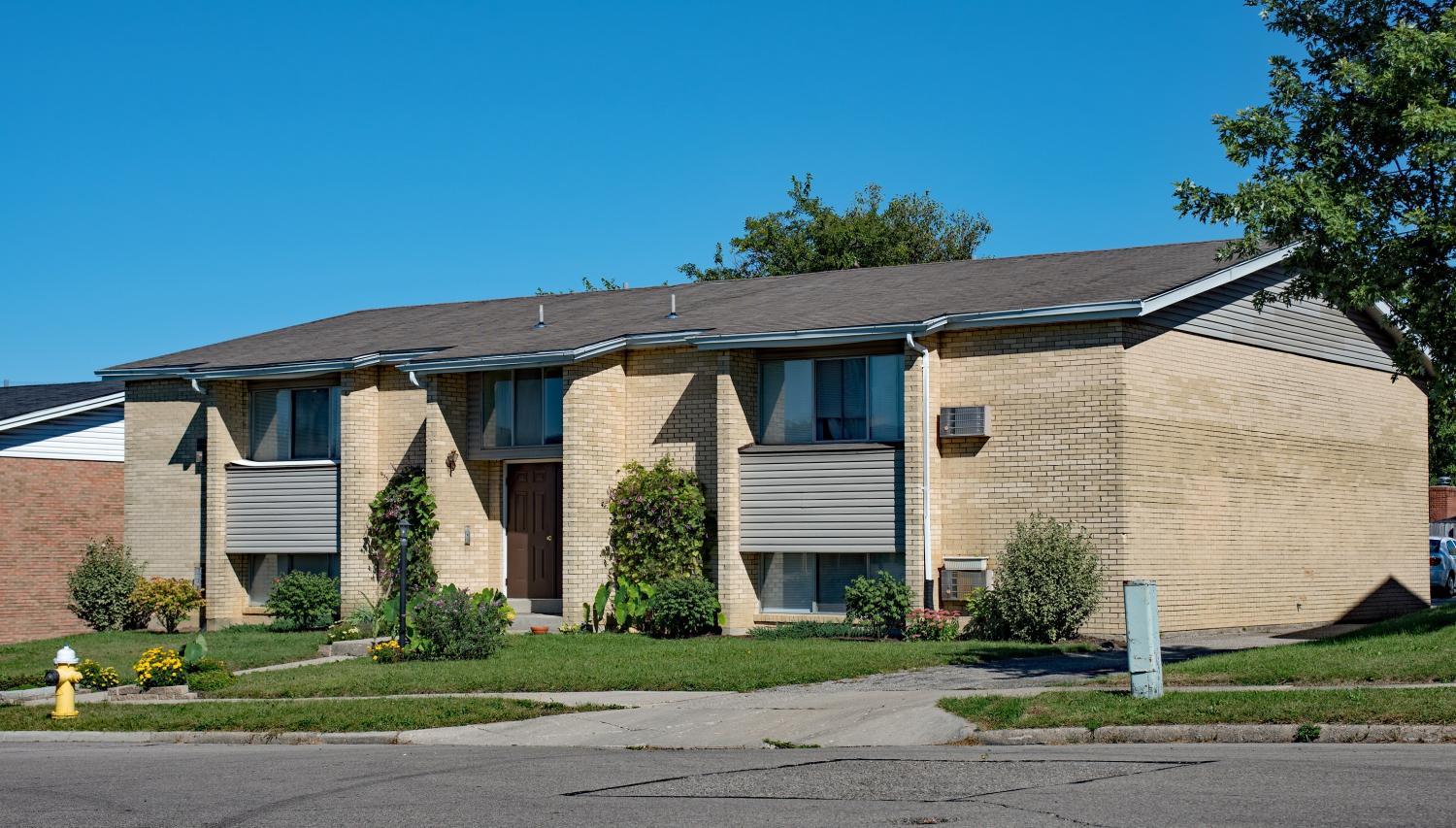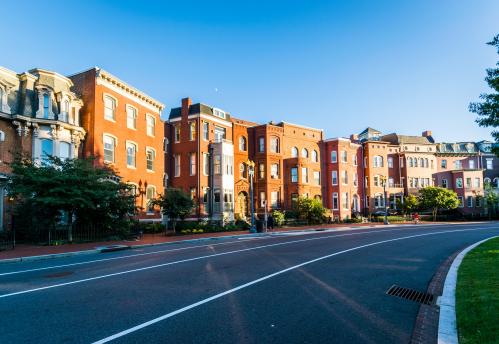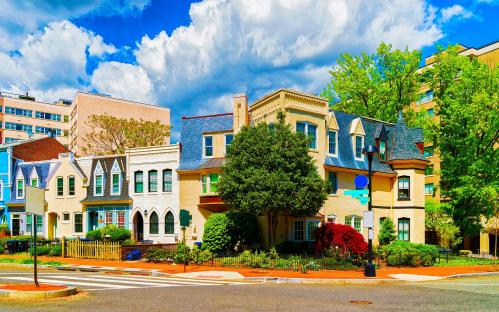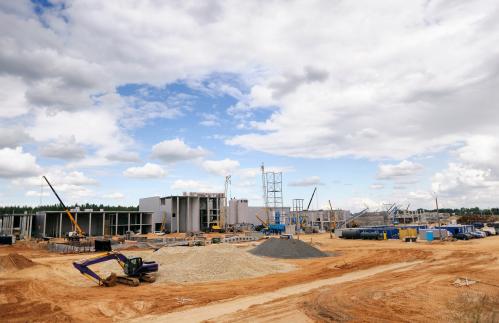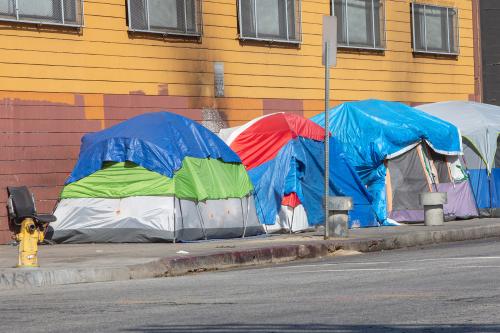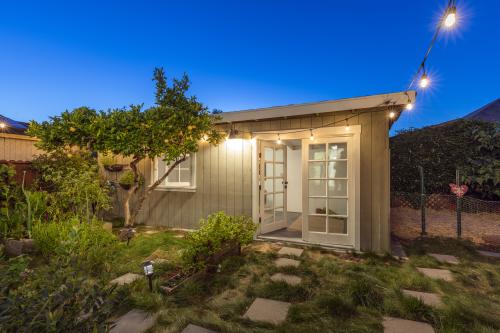Even before the COVID-19 pandemic, millions of Americans lacked stable, affordable housing. Now, the crisis has highlighted the social and economic costs of this crucial gap in the safety net. People living in poor-quality, overcrowded, or unstable housing—or without any home at all—cannot follow public health directives to safely “shelter in place.” As a result, they are at far greater risk of contracting the virus, along with other chronic illness.
Many people in this population also face risks of instability. Housing costs are a major financial stressor for low-income households, who typically devote between a third and a half of their incomes to housing. Cost-burdened households are at risk of losing their homes to eviction or foreclosure, especially during economic downturns. These households are also unable to accumulate savings that could help them weather temporary income losses like so many have seen during the pandemic.
Stable, decent-quality, and affordable housing is also critical for communities and the overall economy. Housing instability can impede workers’ ability to secure and maintain employment. As the Great Recession showed, concentrations of foreclosed and vacant homes create negative spillovers across entire neighborhoods. The housing sector creates multiplier effects throughout the economy, so contractions in construction, upgrades, and sales can translate into reduced employment and consumer spending, deepening the recession. Financial pressure on low-income renters also harms small landlords, who are disproportionately people of color and account for a large share of unsubsidized affordable housing.
Local governments and nonprofit service providers are scrambling to put in place temporary measures to help those who lack stable housing, such as purchasing motels to shelter unhoused families, placing hand-washing stations in homeless encampments, and providing emergency rental assistance. This puts additional strain on the staff and budgets of local governments and nonprofits at a time when resources are especially scarce and long-term planning is hardest.
Future pandemics and natural disasters will put similar strains on housing systems. Once the current public health crisis has been contained, policymakers should make more serious efforts to reduce the number of households who lack affordable, stable, decent-quality housing, and focus on three goals:
- Increase the amount of long-term affordable rental housing, especially in high-opportunity communities.
- Protect existing affordable rental housing from physical deterioration and financial insecurity.
- Support affordable housing projects currently in the pipeline that face financial obstacles due to the pandemic.
In this piece, we explain why each of these goals is critical to supporting affordable housing infrastructure across the U.S. We then explore strategies aimed at achieving the first goal, specifically through the acquisition of existing housing. Several policies used in recent decades offer lessons for the design of similar programs moving forward, providing both examples to emulate and pitfalls to avoid. Future work will explore policy models that support the second and third goals. Finally, we pose a series of policy design questions to help stakeholders tailor policies to local needs and capacities.
Protecting and expanding affordable housing
Successful housing interventions need to reflect local housing market conditions as well as the resources of local governments and other stakeholders. The importance of preserving existing affordable housing versus expanding the inventory will differ across communities, as will the feasibility of acquisition versus new construction. Policymakers need a toolkit of flexible strategies to draw upon to meet the three goals outlined above.
Goal #1: Increase the supply of long-term affordable rental housing
Even before the COVID-19 crisis, housing affordability and instability were serious problems. That’s especially true in high-cost coastal markets and high-opportunity neighborhoods everywhere. The immediate recovery period after the pandemic subsides may offer a rare opportunity: If housing asset prices drop (as widely anticipated), affordable housing providers could purchase existing low-cost units and add them to the stock of long-term affordable housing.
Some (but not all) of these properties may require rehabilitation and maintenance. A program to make this happen would require an initial subsidy allocation from the federal government, philanthropy, or both, in addition to low-cost loans (conveniently, at a time of very low interest rates). State and local governments are anticipating substantial revenue losses due to the economic crisis, so they will likely have limited ability to dedicate additional resources toward affordable housing. Targeting “high-opportunity” neighborhoods—communities with well-paying jobs, access to public transit, and good schools—may be of particular value. Successfully pursuing acquisition takes particular skills—staff capacity as well as resources—so this may not be a universally useful or successful strategy.
Goal #2: Preserve the physical and financial viability of existing affordable rental housing
The economic crisis may also accelerate the deterioration of the affordable housing stock or other elements with limited capital reserves and/or net operating income. Some affordable properties could also be lost if they are sold to market-rate investors who plan to raise rents.
To guard against this, policymakers should protect and preserve existing affordable housing from physical deterioration and financial instability. One strategy would be to offer grants or subsidized loans to current owners in exchange for accepting or extending existing affordability requirements. This may be particularly useful for smaller landlords, who in many markets are disproportionately Black and Latino or Hispanic.
Goal #3: Shore up affordable housing deals in the pipeline
The COVID-19 crisis also threatens the financial viability of housing deals—particularly subsidized housing projects—that are currently in the development pipeline but not yet completed. Shoring up future projects may not be as high a priority for some localities as protecting existing properties, but may be an area for partnerships with private capital sources.
How to expand affordable housing through acquisition
In recent decades, several local and national policies have been used to expand the affordable housing inventory through acquisition of existing buildings. Below, we discuss three local examples—one from King County, Wash., and two from New York City—as well as one federally funded national program.
The King County Housing Authority’s multifamily housing acquisition program
The King County Housing Authority (KCHA) has taken advantage of the flexibility granted by the U.S. Department of Housing and Urban Development’s (HUD) Moving to Work (MTW) program to pursue multifamily housing acquisitions in high-opportunity neighborhoods. MTW exempts participating public housing authorities from many existing public housing and housing choice voucher rules, and provides them with flexibility in how they use their federal funds.
In 2016, King County agreed to provide KCHA with access to the county’s triple-A credit rating to assist in developing or acquiring as many as 2,200 additional units over the next six years. By providing the housing authority with access to lines of credit from lenders, this financing support allows KCHA to act quickly when the opportunity arises to acquire a strategically located property. By securing additional units, KCHA can preserve long-term affordability and provide housing for Section 8 voucher holders in high-opportunity neighborhoods.
MTW’s flexibility has allowed King County to acquire mixed-income properties in high-opportunity areas through bond financing and other private financing tools. Since 2016, KCHA has acquired more than 1,500 units of housing along the region’s emerging mass transit corridors. The acquisition program is possible for two reasons: flexibility in spending federal money and strong credit ratings for both KCHA and King County.
New York City’s 10-year plan
Like many U.S. cities, New York City suffered substantial population losses during the 1970s. By the end of the decade, it had taken ownership of more than 100,000 vacant and occupied apartments as well as large tracts of vacant land through tax foreclosure. The city struggled to manage this vast stock of housing and land, and in 1985, Mayor Ed Koch announced an ambitious 10-year program, expanding it a few years later to commit $5.1 billion of city capital to create or preserve 252,000 housing units for low-, moderate-, and middle-income households. By 2000, the plan had created 66,000 new housing units through construction or gut rehabilitation of vacant properties, and the renovation of another 116,000 occupied units.
The 10-year plan comprised a wide range of programs which provided subsidies to both nonprofit and for-profit developers. Generally, the city transferred land or buildings to developers at little or no cost and also provided capital subsidies in the form of below-market interest rate loans. Research shows that this effort was successful in not only providing about 200,000 homes, but it also aided in revitalizing neighborhoods that had been devastated by abandonment and arson.
While the 10-year plan wasn’t technically an acquisition program, there are lessons to be gleaned. First, with control of land, the city was able to lock in affordability before markets later recovered. One can argue about whether the affordability restrictions lasted long enough, but the program clearly boosted the supply of affordable homes. Second, the struggles the city faced in managing this large housing stock raise a cautionary note, and underscore the importance of quickly transferring ownership to capable and responsible nonprofit and for-profit owners. Third, while the scale of this program cannot be replicated, there was clearly value in creating off-the-shelf programs that multiple developers could use. Fourth, the city aimed at revitalizing neighborhoods, and as such, clustered its property transfers on particular blocks, aiming to create housing that could serve a mix of low-, moderate-, and in some cases, middle-income households.
New York City Acquisition Fund
Launched in 2006, the New York City Acquisition Fund aimed to provide flexible funds to mission-driven developers to acquire and preserve affordable buildings which might otherwise be sold to speculative investors. The aim was to fill the need for flexible predevelopment loans that would allow affordable housing developers to act nimbly and buy available properties.
The Fund, which was started with initial seed capital from several philanthropic organizations, provides capital for acquisition and predevelopment costs more quickly than other government programs. Foundation and city funds take first losses, while private lenders provide additional capital. Each dollar the city has invested in the Fund has leveraged $7 additional private dollars. The Fund is managed through a revolving credit facility. Three community development financial institutions (CDFIs) serve as originating lenders, and an asset management fund manages the Fund.
Over its first 10 years, the Fund provided $336 million in financing to create over 10,000 affordable homes, with 75% reserved for low-income residents. As successful as the program has been, one limiting factor has been that the city has to negotiate and underwrite each deal separately. There could be substantial advantages to structuring subsidies as part of an as-of-right financing package with affordability restrictions that would not require project-by-project negotiations.
Neighborhood Stabilization Program
The federal government created the Neighborhood Stabilization Program (NSP) to mitigate the impact of concentrated foreclosures in low-income neighborhoods during the 2007-2009 housing crisis. HUD allocated nearly $7 billion over three rounds of funding to local and state governments and nonprofit organizations. Funds could be spent on various activities intended to reclaim and reutilize vacant properties; in practice, most grantees used NSP funds either to acquire and rehabilitate properties or demolish vacant structures. The program initially targeted single-family homes, which accounted for most foreclosures. However, grantees in strong real estate markets—including New York City, Chicago, Boston and Washington, D.C.—used NSP funding to acquire and rehab multifamily rental properties, adding them to the long-term affordable inventory.
The primary focus on acquiring existing properties, rather than new construction, makes NSP quite different from the Low-Income Housing Tax Credit (LIHTC) and most other affordable housing programs. Acquisition offers two primary advantages over new construction, especially in high-cost housing markets. First, the per-unit cost of creating long-term affordable housing is much lower (even when properties require some rehab), which allows limited subsidy dollars to stretch farther. Second, in housing markets with highly restrictive local land use regulations, developing a new apartment building can take a decade or more. Acquiring existing buildings in relatively good physical condition can make affordable units available to low-income households much faster.
NSP grantees encountered some implementation difficulties that offer lessons for future programs. Most importantly, many organizations had limited prior experience in acquiring and rehabilitating vacant homes, while grantees with existing expertise were able to deploy resources more quickly and effectively. Some local governments had to work around institutional barriers such as procurement rules that hindered their ability to make strategic acquisitions.
The program’s rules also posed some challenges. The short timeline for committing funds (typical for stimulus spending programs) pushed some grantees to pursue acquisitions that did not meet their larger strategic goals. A requirement to purchase properties at discounted prices hindered grantees’ ability to compete with private investors.
One tension within the NSP was conflict among multiple goals. As part of the larger economic stimulus package, NSP grantees wanted program funding to support residential construction jobs through the rehabilitation work. But properties that needed extensive rehab had substantially higher per-unit costs, resulting in fewer units being acquired. The COVID-19 crisis is likely to create similar dilemmas for local organizations; developing a clear strategy and priorities early would help guide consistent actions later.
While NSP was explicitly meant to support hard-hit neighborhoods through geographically concentrated activity, distressed properties may be more dispersed in the current crisis. This suggests that the recovery period following COVID-19 could offer an unusual opportunity to increase the availability of affordable housing in high-opportunity neighborhoods—a different strategy than mitigating blight.
Tailoring policy toward local goals, resources, and market conditions
As policymakers develop strategies to address critical needs in their communities, there is a range of policy design questions that can help them tailor their programs.
- What are the highest priorities for the community? Policymakers in high-cost markets may place greater weight on ensuring long-term affordability for properties in appreciating neighborhoods. Communities with an older housing stock will have more properties in poor physical condition that could otherwise become uninhabitable.
- What kinds of entities should be eligible to participate? The ecosystem of affordable housing providers varies substantially across communities, including public agencies, nonprofit organizations, and for-profit firms. With appropriate affordability guidelines, any of these entities could be useful partners.
- Are local governments prepared to be long-term owners and/or property managers, or is the goal to transfer ownership to non-public-sector owners (either nonprofit or for-profit)? With the exception of local housing authorities, most local governments have little experience with property management and limited staff capacity to take this on.
- Are there opportunities to utilize alternative ownership models, such as community land trusts and limited equity cooperatives? These structures can secure long-term affordability and provide greater community voice.
- How can public funds be structured to leverage philanthropic or private funds without adding unnecessary complexity? The New York City Acquisition Fund and the Washington Housing Conservancy offer two models for flexible investment vehicles.
- How should long-term affordability provisions be designed and implemented? Without deep subsidies, it is difficult to make housing affordable to low-income households. Income-mixing at the project level can increase financial stability, while mixed-income neighborhoods offer residents greater economic opportunity.
Don’t let a crisis go to waste
The COVID-19 crisis has drawn widespread attention to the existing inequalities in American society, including disparate racial health impacts and the financial fragility of low-wage workers. As policymakers and voters become more aware of the social costs created by housing instability, there is an opportunity to address long-standing gaps in the safety net. Achieving meaningful reductions in housing insecurity will require more resources—and more thoughtful strategies—from public agencies, philanthropy, and private capital.
Thanks to Sarah Crump for excellent research assistance.
The views expressed in this article are solely those of the authors and do not necessarily reflect the views of the Federal Reserve Bank of Boston or the Federal Reserve System. Any errors or omissions are the responsibility of the authors.




